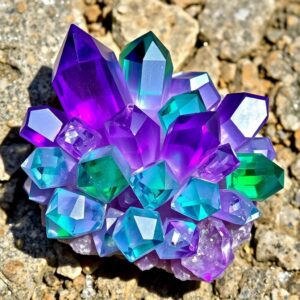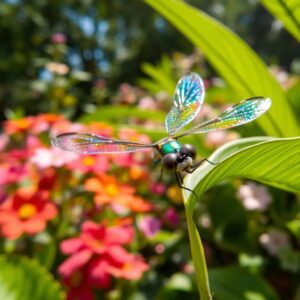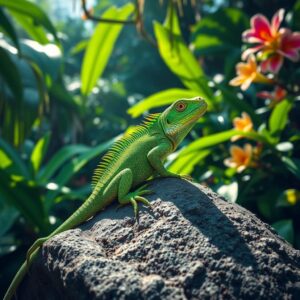
Explore & Play
Discover interesting topics and solve the accompanying crossword puzzle.
Lizard Crossword | Fascinating World of Lizards
Play the Lizard crossword and explore a world of fascinating lizard species. Learn about their unique traits and behaviors in this detailed article.
Table of Contents
Start by testing your knowledge with the Lizard crossword, and then dive into the article to expand your understanding of these fascinating reptiles. If you’re not yet familiar with the topic, feel free to read through the article first and return to the crossword for a fun challenge after learning more
Lizard Crossword
You can either fill in the crossword puzzle directly on this page or click the button in the bottom right corner to print it for free.

Exploring the World of Lizards: From Iguanas to Monitor Lizards
Lizards are among the most diverse and ancient creatures on Earth, ranging from small geckos to giant monitor lizards, with an incredible variety of species to explore. This article takes you through the fascinating world of lizards, from the iconic iguanas to the giant monitor lizards, and everything in between.
1. What Defines a Lizard?
At its core, a lizard is a reptile, but what truly defines them is their unique features that distinguish them from other reptiles. From their scaly skin to their clawed feet, lizards are easily identifiable. But what makes these creatures even more intriguing is their ability to adapt to a wide range of environments.1.1 Key Characteristics of Lizards
Lizards typically have scaly skin that helps protect them from the elements, and most species have claws that assist them in climbing, hunting, and defending themselves. One of the most fascinating features of lizards is their ability to regenerate their tails when threatened. This serves as a survival mechanism, as a predator may focus on the tail while the lizard escapes. Furthermore, many lizards are known for their incredible agility and speed, traits that help them escape predators and capture prey.1.2 Common Misconceptions About Lizards
Despite their common presence in folklore and media, there are several misconceptions about lizards. For instance, many people assume all lizards are venomous, but this is not the case. In fact, most lizards are completely harmless to humans. Another common myth is that all lizards are dangerous or aggressive, but in reality, many species are shy and prefer to avoid contact with humans. Understanding these misconceptions is key to appreciating these reptiles for what they truly are.2. The Iguana Family: The “Green Giants”
Iguanas are some of the most well-known and beloved lizards worldwide, with the Green Iguana being a staple of reptile households and zoos. But iguanas are more than just pets; they are fascinating creatures with a range of unique traits and adaptations.2.1 Green Iguana
Native to Central and South America, the Green Iguana is a large herbivorous lizard that is highly adaptable and famous for its vibrant green color. These lizards can grow to over 5 feet in length and are equipped with powerful tails and sharp claws for climbing and defense. They are primarily tree-dwellers, using their long, muscular tails for balance as they move through the canopy. Green Iguanas are herbivores, feeding mainly on leaves, flowers, and fruit, making them an important part of their ecosystems.2.2 Other Members of the Iguana Family
While the Green Iguana is the most famous, the iguana family also includes other remarkable species like the Marine Iguana of the Galapagos Islands and the Spiny-tailed Iguana.2.2.1 Marine Iguana
The Marine Iguana is unique for its ability to dive into the ocean, feeding on algae and returning to the land to warm up under the sun. Found exclusively on the Galapagos Islands, this species has evolved to thrive in harsh, coastal environments. Marine Iguanas are excellent swimmers, using their long, powerful tails to propel themselves underwater as they forage for food. Their ability to tolerate the cold waters and warm up by basking in the sun makes them one of the most fascinating reptile species in the world.2.2.2 Spiny-tailed Iguana
Found primarily in Central America, the Spiny-tailed Iguana is known for its sharp, spiny tail and its ability to thrive in harsh, dry environments. This species is often found in rocky, arid landscapes, where it uses its tough skin and spiny tail to defend itself from predators. Unlike many other lizards, Spiny-tailed Iguanas are more territorial and aggressive, making them an interesting subject of study for reptile enthusiasts.3. The Monitor Lizard Family: Rulers of the Reptile World
Monitor lizards, including the famous Komodo Dragon, are among the largest and most formidable lizards, with some species growing up to 10 feet long. These lizards are known for their intelligence, strength, and incredible adaptability, making them a dominant force in the reptile kingdom.3.1 Komodo Dragon
The Komodo Dragon, native to Indonesia, is a true giant among lizards, growing up to 10 feet in length and capable of taking down large prey. This apex predator is known for its powerful bite, which delivers venom that can incapacitate its prey. Despite their fearsome reputation, Komodo Dragons are often solitary creatures, spending much of their time in search of food or sunning themselves on the island’s volcanic terrain. Their incredible size and hunting prowess make them one of the most iconic reptiles on Earth.3.2 Other Notable Monitor Lizards
Monitor lizards are a highly diverse group, ranging from small species like the Black Tree Monitor to the massive Water Monitor. Each species in the monitor family has unique characteristics that help it thrive in its environment.3.2.1 Black Tree Monitor
This small but agile monitor lizard is native to New Guinea and is often seen in the trees, where it hunts for insects and small vertebrates. The Black Tree Monitor is known for its sharp claws and long, prehensile tail, which it uses to navigate the treetops with remarkable dexterity. Its black and green coloration helps it blend into the foliage, making it an efficient hunter and a skilled climber.3.2.2 Water Monitor
Water monitors are large, semi-aquatic reptiles that thrive in tropical environments, and they are known for their ability to swim and dive for food. These lizards can grow up to 10 feet in length and are often found near water sources, such as rivers, lakes, and coastal regions. Their powerful tails and webbed feet make them exceptional swimmers, and they are known to hunt a wide range of prey, including fish, birds, and small mammals.4. Chameleons: Masters of Color Change
Chameleons are among the most famous lizards due to their ability to change color, a fascinating skill used for camouflage and communication. Their extraordinary visual abilities, combined with their prehensile tails and zygodactylous feet, make them one of the most specialized groups of lizards.4.1 How Chameleons Change Color
The ability to change color is not just for camouflage—it is also a way for chameleons to communicate with other chameleons and regulate their body temperature. Chameleons have specialized cells called chromatophores, which contain pigments that can expand or contract to change the color of the skin. This remarkable ability helps them blend into their environment to avoid predators, but it also allows them to express their emotions and territorial status.4.2 Types of Chameleons
Chameleons are found primarily in Africa and Madagascar, but there are also species in parts of Asia and Europe, each with unique color-changing abilities. Among the most famous chameleons are the Veiled Chameleon and the Madagascar Chameleon, both of which are prized for their vibrant hues.4.2.1 Veiled Chameleon
The Veiled Chameleon, known for its large, “veiled” head structure, is a popular pet and can display a wide range of colors. Native to the Arabian Peninsula, the Veiled Chameleon uses its ability to change color not only for camouflage but also to regulate its temperature in the hot, dry environment.4.2.2 Madagascar Chameleon
The Madagascar Chameleon is famous for its vibrant hues and is a symbol of the diverse wildlife found on the island of Madagascar. Known for its size and color-changing abilities, this species is one of the most striking examples of the chameleon family, with some individuals displaying brilliant shades of green, blue, and yellow.5. Geckos: The Tiny Giants of the Lizard World
Geckos, although small, are one of the most diverse groups of lizards, and they exhibit a range of unique behaviors and physical traits. These lizards are known for their ability to cling to surfaces, making them excellent climbers.5.1 The Geckos of the World
Geckos are found on every continent except Antarctica, and their ability to cling to surfaces with ease is one of their most amazing traits. This skill is due to their unique footpads, which have microscopic hairs that allow them to adhere to smooth surfaces, even glass. Geckos are also known for their vocalizations, with some species making a range of sounds to communicate with others.5.2 Famous Geckos
Some of the most famous geckos include the Leopard Gecko, the Tokay Gecko, and the Leopard Anole, each known for their unique appearance and behavior.5.2.1 Leopard Gecko
Leopard Geckos are popular pets due to their easygoing nature and beautiful spotted patterns that resemble those of leopards. These geckos are native to the deserts of Asia and the Middle East, where they are known for their nocturnal behavior and ability to survive in arid environments.5.2.2 Tokay Gecko
The Tokay Gecko is known for its loud call and vibrant blue and orange skin, making it one of the most striking gecko species. This species is often found in Southeast Asia, where it hunts insects and small vertebrates. The Tokay Gecko is also famous for its territorial behavior and aggressive nature, which makes it a fascinating species to observe in the wild.6. Unique and Lesser-Known Lizards
While the Iguana and Monitor families dominate the reptile world, many other lizards have fascinating features that make them stand out in their own right.6.1 The Bearded Dragon
The Bearded Dragon is an iconic pet lizard known for its distinctive “beard,” a flap of skin that can be expanded to make the lizard appear larger when threatened. Native to Australia, these lizards are omnivores, eating a diet of insects, plants, and small animals. Their friendly and docile nature makes them popular pets worldwide.6.2 The Skinks
Skinks are a family of lizards with elongated bodies and short limbs, which gives them a unique appearance compared to other lizards. These lizards are often burrowing creatures, living in a range of habitats from deserts to forests. One of the most interesting features of skinks is their ability to shed their tail when threatened, a defense mechanism that allows them to escape while the predator focuses on the tail.In Summary: A World of Fascinating Lizards Awaits
From the giant Komodo Dragon to the tiny Geckos, lizards are an incredibly diverse and fascinating group of reptiles. Whether you’re drawn to their vibrant colors, unique behaviors, or their ability to adapt to almost any environment, there’s no shortage of reasons to appreciate these remarkable creatures. Ready to test your knowledge of lizards? Dive into the “Lizard Species Crossword” now and see how much you’ve learned about these fascinating reptiles!Share to...
Thank you for reading 👋
I hope you enjoy the content.
I hope you enjoy the content.
Want to receive our daily crossword puzzle or article? Subscribe!
You may also be interested in
Share to…
Want to receive our daily crossword puzzle?
-
Jigsaw Puzzles
Chinese Zodiac Serpent Watercolor Jigsaw Puzzle 250 | 300 | 500 Pieces
kr 348,00 – kr 439,00Price range: kr 348,00 through kr 439,00 Select options This product has multiple variants. The options may be chosen on the product page -
Jigsaw Puzzles
Cozy Art Nouveau Cat Puzzle 250 | 300 | 500 Pieces
kr 348,00 – kr 439,00Price range: kr 348,00 through kr 439,00 Select options This product has multiple variants. The options may be chosen on the product page -
Jigsaw Puzzles
Fjord Elegance: Abstract Jigsaw Puzzle 250 | 300 | 500 Pieces
kr 348,00 – kr 439,00Price range: kr 348,00 through kr 439,00 Select options This product has multiple variants. The options may be chosen on the product page

















